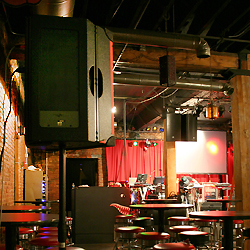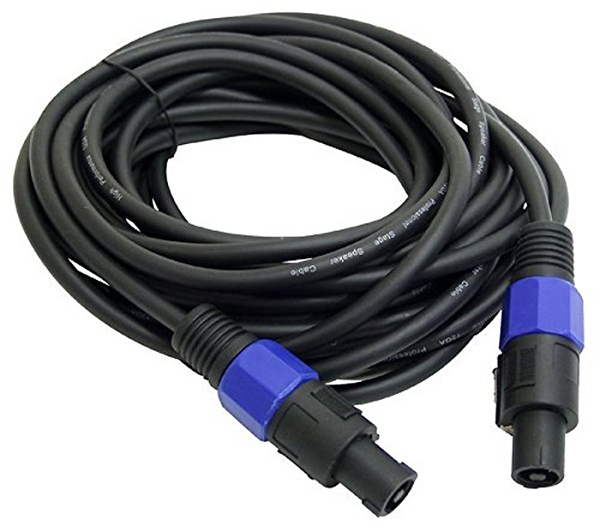Sometimes the differences between a good and a great system design are the “little things” like cables, connectors, mounts, stands, rigging, and so on. So let’s shine a bit of light on these often overlooked aspects.
Loudspeaker cables come in many styles and lengths but they all do the same thing, which is to provide two conductors to connect a passive loudspeaker to its respective amplifier output. The rule of thumb is simple: “Use the largest gauge cable possible and run it the shortest length possible.” Large gauge conductors better transmit power while shorter length enhances damping factor.
What is damping? Consider how a loudspeaker driver works. A woofer tends to have a large mass (cone) attached to a smaller voice coil and suspension. When given a signal, the cone moves, and when the signal stops, the cone tends to keep moving in the same direction because of its inertia. This can produce an audible signal at the driver’s resonant frequency.
The effect is more pronounced in cone transducers because they have a larger mass attached to a comparatively weak suspension that could help “dampen” cone movement mechanically. High-frequency drivers usually have the reverse setup of a small mass attached to a relatively stiff surround and do not exhibit this phenomena as much.
Most drivers use a coil of wire surrounded by a magnet that moves the cone back and forth. This also generates a current back to the output circuitry of the amplifier, which acts as a load for any current generated by a voice coil. Amplifiers can “dampen” or decrease the amount of cone movement with low-output impedance. Both longer-length and smaller-gauge cables increase the resistance in the circuit, lowering the damping effect and often producing “muddy sounding” bass performance.
In pro audio, 12-gauge conductors are common in wire for loudspeakers. Also popular is 13-gauge found in multi-conductor wire for loudspeaker cables, with the slightly smaller gauge not affecting power handling or damping factor ratings to a great extent when used at shorter lengths. It also makes for a lighter and smaller outer diameter cable size.
Vital Links
A variety of connectors can be employed with loudspeaker cables. 1/4-inch phone plugs are common for lower power “MI-grade” loudspeakers (as well as guitar amplifier extension cabinets). A bigger shell is common with this connector when used with loudspeaker cables so it can accommodate the larger gauge wires. It doesn’t lock into place and can easily be pulled out of its socket.
The most common connector for professional loudspeakers is the 4-pin speakON from Neutrik. It can be used to supply a single connection for a passive cabinet, a dual connection to a bi-amped loudspeaker, and also to link two loudspeakers. A full-range loudspeaker can be wired for the second set of pins, with a single 4-pin cable linking it and a subwoofer via a pass-through (“pass-thru”) output.
Many modern amplifiers also offer speakON connectors as outputs in addition to binding posts. One of the connectors also has the other amplifier channel wired on pin 2 so both channels of the amplifier can be used with a single cable for bi-amping or for running a full-range cabinet with a subwoofer. Neutrik also offers an 8-conductor speakON connector that’s frequently utilized in larger system designs and/or as a single connector for 3- and 4-way loudspeakers. Another 2-conductor speakON can handle a single channel, perfect for a single passive full-range cabinet or monitor.
Also popular for large arrays and clusters are 19-pin Socapex or Veam connectors. They’re mated to multi-core 12-gauge cable and can supply six to nine audio circuits to a group of loudspeakers. In use, a breakout fan is attached to the multi-pin, branching the signal to individual cabinets. At the amplifier end, a panel is mounted on the amp rack that has corresponding 19-pin panel mount connectors wired into the amps, making for a quick and easy connection to the loudspeakers.
Powered loudspeakers, of course, eliminate some cabling needs, but they still need both AC power and signal connections to operate. The signal input requires a line level feed from the console using a standard XLR connector. A separate power cord using an IEC or locking Neutrik powerCON connector is required to supply AC to the loudspeaker’s built-in amplifier and DSP. This can require two separate cables, but several manufacturers have developed alternatives.
For example, Rapco Horizon offers the AC-Audio Composit with an XLR connector/cable for signal and an IEC-to-Edison connector/cable for power in a single jacket. This means just one cable run, and particularly with powered monitors, it can result in a cleaner, less cluttered stage.

Many users deploy 19-pin cables to deliver AC to large arrays of powered loudspeakers, run from a power distributor (PD) with a 19-pin output. It’s a single cable approach providing up to six 20-amp circuits. It’s also common these days to see PDs and amplifier racks flown with arrays, shortening cable runs.
We also see custom cable assemblies/packages sold with loudspeaker systems or ordered from a cabling provider. For example, Link makes OEM packages for RCF, Adamson and others, and the company has also developed a line of 24-, 36- and 48-conductor multi-cable and connectors for high-channel-count arrays. In addition, Link offers hybrid cable systems that can carry digital network audio, power, loudspeaker and inclinometer signals.

















